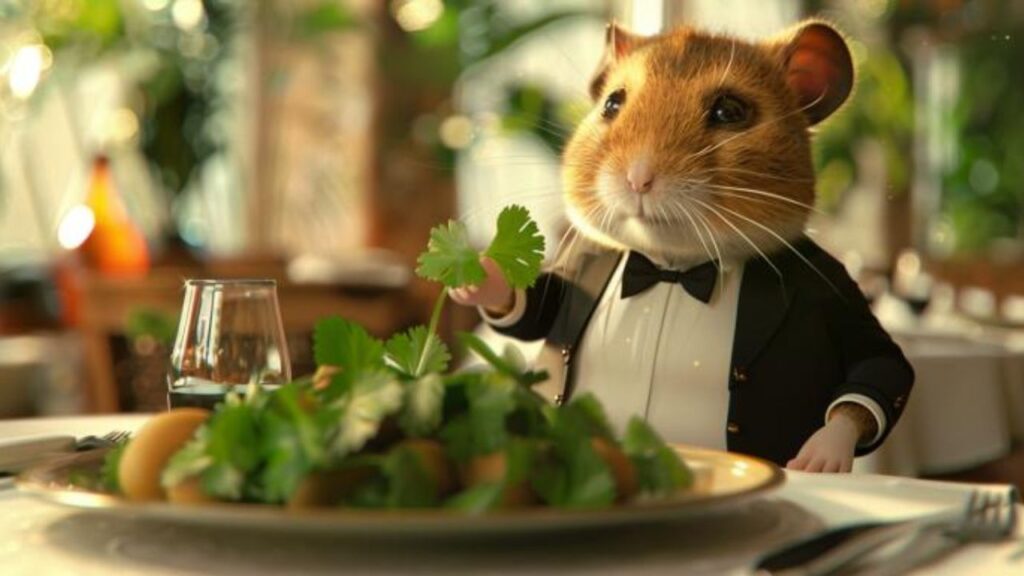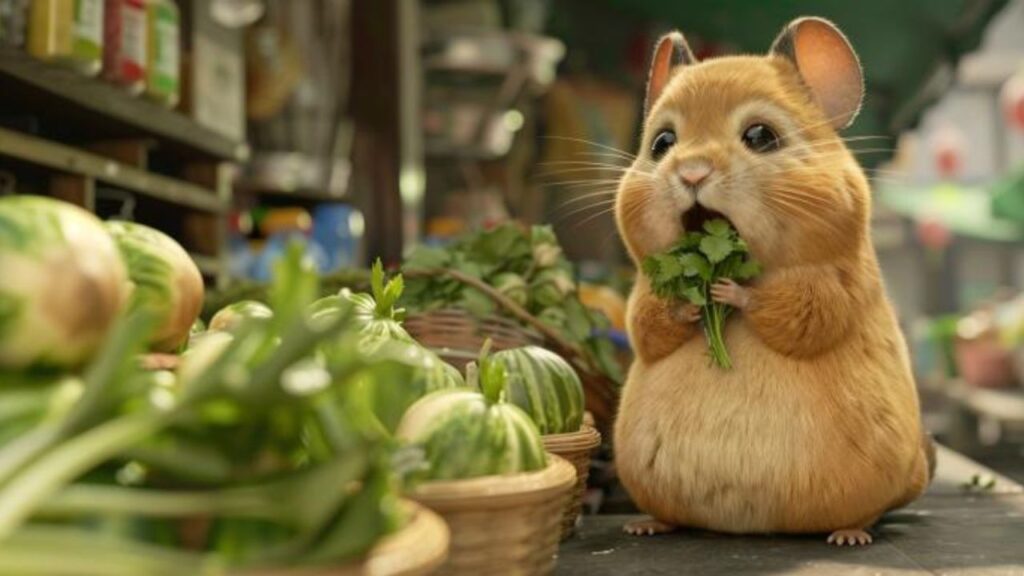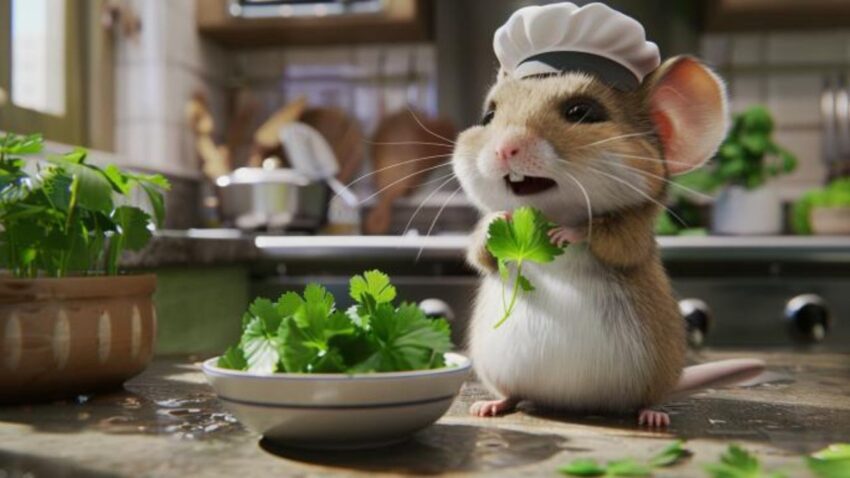TL;DR Summary
Yes, hamsters can eat cilantro in very small amounts as an occasional treat. Cilantro contains vitamins A, C, and K, which can be beneficial to a hamster’s health. However, introduce cilantro slowly to watch for any digestive issues, and always serve it finely chopped to prevent choking. Ensure cilantro does not replace staple foods in your hamster’s diet, and if any adverse reactions occur, remove cilantro from their meal plan. Remember, a diverse diet with a sprinkle of cilantro can make for a wheel-y happy hamster!
Hamsters, those charming little creatures with a penchant for hoarding and nibbling, have a surprisingly complex dietary needs that go beyond the typical seed mix. Just like humans, these small rodents benefit from a diverse range of foods that include more than just grains and proteins; they also thrive with the inclusion of fresh vegetables and herbs. But when it comes to adding these leafy greens to a hamster’s diet, pet owners must navigate a labyrinth of do’s and don’ts to ensure the health and well-being of their furry companions.
The Spice of Life: Variety in a Hamster’s Diet
A well-rounded hamster diet mimics the diversity of their wild ancestors’ foraging finds. In their natural habitat, hamsters consume a variety of grasses, seeds, insects, and occasional fruits and herbs. This diversity is not just to appease their taste buds; it provides a range of essential nutrients. In captivity, achieving this balance means incorporating fresh produce and select herbs into their daily feedings, all the while ensuring these additions are safe and beneficial for your hamster.
Understanding Herbs in the Context of Hamster Nutrition
Herbs can be more than just a garnish; they often contain a wealth of vitamins and minerals. Cilantro, for example, is rich in Vitamin K, essential for blood clotting, and Vitamin A, which supports healthy vision. However, the unique digestive systems of hamsters process these herbs differently than humans do, which means that some herbs that are healthy for us might not be suitable for them.
Can Hamsters Eat Cilantro?
This brings us to the heart of our leafy discussion: cilantro. This popular culinary herb is known for its fresh, distinctive taste and is a staple in many kitchens. But the question at paw is, can hamsters safely consume cilantro as part of their varied diet? In the following sections, we will sift through the leaves of information to provide clarity on whether cilantro belongs in your hamster’s food bowl.
Cilantro’s Nutritional Composition

Diving into the green lushness of cilantro, also known as coriander, it’s not just a flavorful addition to human cuisines, but a potential nutrient-packed herb for hamsters. Understanding what cilantro is made of is key to determining its place in your hamster’s diet.
What Nutrients Does Cilantro Offer?
Cilantro is more than its vibrant taste; it is a rich source of dietary essentials. It’s low in calories but high in vitamins and minerals that are vital for maintaining good health in small doses.
Vitamins
Cilantro is a fresh source of Vitamin A, which plays a critical role in maintaining healthy vision, skin, and immune function in hamsters. This herb is also rich in Vitamin C, an antioxidant that can help hamsters with tissue repair and enzymatic production of certain neurotransmitters. It contains Vitamin K as well, necessary for proper blood clotting and bone metabolism.
Minerals
In terms of minerals, cilantro offers potassium, which is necessary for proper muscle function and maintaining fluid balance in the body, and manganese, which is involved in bone formation and blood clotting. There are also traces of calcium and magnesium, which support bone health and help regulate nerve and muscle function.
Dietary Fiber
Cilantro contains a small amount of dietary fiber, which can aid in digestion for hamsters by helping to regulate their bowel movements. However, too much fiber can lead to digestive issues, so cilantro should be given in moderation.
Analysis of Cilantro’s Nutritional Value for Hamsters
While the aforementioned nutrients in cilantro are beneficial, it’s crucial to factor in the unique needs and limitations of a hamster’s diet. Given their size, hamsters require only minuscule amounts of these nutrients, and their daily intake should be monitored closely to prevent overconsumption.
In terms of energy provision, cilantro is relatively low in sugar and fat, making it a good choice for an occasional treat. The herb’s water content can also aid hydration, which is especially beneficial for hamsters that may not drink ample water on their own.
However, the richness in vitamins such as Vitamin A and Vitamin K means cilantro should be offered sparingly to avoid any issues related to fat-soluble vitamin accumulation, which can be problematic in excessive amounts.
In conclusion, cilantro can be a nutritious supplement to a hamster’s diet when served properly. It’s not a necessary item, but it can be a beneficial treat that introduces variety and essential nutrients into their routine. As with all things in a hamster’s life, balance and moderation are the keys to a healthy and happy pet.
The Benefits and Risks of Feeding Cilantro to Hamsters

When considering fresh additions to your hamster’s menu, cilantro may come up as a fragrant candidate. This leafy herb isn’t just for garnishing dishes; it may also provide some health perks for our little friends. However, it’s essential to weigh these benefits against potential risks to ensure our hamsters lead healthy, happy lives.
Is Cilantro Good for Hamsters?
Health Benefits of Cilantro
Incorporating cilantro into your hamster’s diet can have several positive effects, primarily due to its nutrient content. Here’s how cilantro can be beneficial:
- Vitamin Richness: Cilantro is high in vitamins A and K, which support various aspects of a hamster’s health, including vision, skin health, and proper blood clot function.
- Antioxidant Properties: The presence of vitamin C provides antioxidant benefits, which can help reduce inflammation and bolster the immune system.
- Digestive Aid: A small amount of dietary fiber found in cilantro can promote healthy digestion in hamsters.
- Hydration Boost: Cilantro has a high water content, which can help keep your hamster hydrated.
Potential Risks
Despite these benefits, there are some considerations to keep in mind when feeding cilantro to hamsters:
- Digestive Sensitivity: Hamsters have sensitive digestive systems, and introducing a new food can sometimes cause gastrointestinal upset, particularly if given in large amounts.
- Nutrient Imbalance: While cilantro offers nutritional perks, too much can lead to an imbalance, especially since hamsters require only tiny amounts of these nutrients.
- Oxalic Acid Content: Cilantro contains oxalic acid, which in larger quantities could lead to the formation of kidney stones. It’s unlikely that a hamster would eat enough cilantro for this to become a concern, but it’s a risk to be aware of nonetheless.
Discussing the Pros and Cons of Cilantro in a Hamster’s Diet
When deciding to add cilantro to your hamster’s diet, it’s essential to start with very small amounts to see how they tolerate it. Introduce cilantro slowly into their diet and observe their reaction over time. Look for signs of enjoyment, such as eager eating or foraging behavior, and also watch for any negative responses like diarrhea or changes in stool consistency, which could indicate digestive distress.
If your hamster tolerates cilantro well and seems to enjoy it, you can continue to offer it in small, controlled portions as an occasional treat, not a daily dietary component. Always finely chop the cilantro to make it easier for your hamster to eat and digest.
In summary, cilantro can be a “sprig of life” for hamsters when provided in moderation and with careful monitoring. It’s a herb that can offer a variety of health benefits, but it’s not without its risks. As with any change to your hamster’s diet, it’s always best to consult with a veterinarian—particularly one specializing in small animals or rodentology—if you have any concerns or questions about what’s best for your furry little charge.
How to Safely Introduce Cilantro to Your Hamster

Ensuring a smooth and safe introduction of cilantro to your hamster’s diet is paramount to their health and well-being. Here’s a step-by-step guide to help you navigate the process of offering this aromatic herb to your hamster.
Cilantro Feeding Guide for Hamster Owners
Step 1: Start with Fresh, Clean Cilantro
Choose fresh cilantro that’s free from pesticides and chemicals. Organic is best, but if that’s not available, rinse the cilantro thoroughly under cold water to wash away any potential residues.
Step 2: Introduce Slowly
Begin by offering a small piece of a cilantro leaf, no larger than the size of your hamster’s paw. This tiny portion will allow you to monitor your pet’s reaction to this new food without overwhelming their system.
Step 3: Observe Your Hamster
After the initial offering, watch your hamster closely for the next 24 to 48 hours. Look for any changes in behavior, appetite, or stool consistency that might indicate a negative reaction to the herb.
Step 4: Gradual Incrementation
If there are no adverse reactions after the first introduction, you can slowly increase the amount of cilantro over time. Still, keep the servings small—cilantro should only be a complement to their diet, not a mainstay.
Step 5: Chop Finely
To aid in digestion and prevent choking, chop the cilantro into fine pieces that your hamster can easily manage.
Step 6: Maintain Diet Variety
Ensure that cilantro doesn’t replace other vital components of your hamster’s diet. Continue offering a variety of foods, with cilantro as an occasional treat.
Step 7: Remove Uneaten Cilantro
Don’t leave cilantro in your hamster’s cage for extended periods. If they haven’t eaten it within 12 hours, remove it to prevent spoilage and the growth of harmful bacteria.
Step 8: Stay Informed on Quantity
Remember that cilantro should make up no more than 10% of your hamster’s total diet. Even if they adore it, it’s important to keep the amount in check to maintain nutritional balance.
Step 9: Continuous Monitoring
Even after your hamster has been eating cilantro without issues, continue to monitor their health as part of your regular care routine. Changes can occur over time, and it’s important to stay vigilant.
Step 10: Consult with a Vet
If you ever have doubts or see signs of health issues, don’t hesitate to consult with a veterinarian who has experience with hamsters.
By following this guide, you can safely introduce cilantro into your hamster’s diet and offer them a new, tasty experience without risking their health. The introduction of any new food should be handled with care and attention to your pet’s specific needs and preferences. Remember, a mindful approach to your hamster’s nutrition can lead to a long, happy, and healthy life for your tiny companion.
Whisker Tips: Introducing Cilantro to Hamster Diets

Adding cilantro to your hamster’s diet can be a delightful way to provide some variety and extra nutrition. But as with any treat, there are right ways to do it that ensure your hamster enjoys their herbs safely. Let’s roll through some quick, practical Whisker Tips to keep your hamster nibbling happily.
Tips for Incorporating Cilantro
Freshness First
Always start with the freshest cilantro you can find. Fresh herbs are more likely to be enjoyed by your hamster and are richer in the nutrients that make them worthwhile.
Wash Thoroughly
Even if it’s organic, give the cilantro a good rinse under cold water to clean off any dust or unseen residue before serving it to your furry friend.
One Leaf at a Time
Hamsters are tiny, and their portions should be too. A small piece of a cilantro leaf is plenty for them to get a taste without overwhelming their system.
Go Slow
Introduce cilantro gradually into your hamster’s diet. Start with a tiny bit once a week, then observe and adjust as necessary.
Chop Chop!
Finely chop the cilantro to make it easier for your hamster to eat and digest. This helps prevent the risk of choking on larger pieces.
Keep It Sparse
Cilantro should be an occasional treat, not a regular part of the diet. Too much of any treat can cause digestive issues or nutritional imbalances.
Mix It Up
Combine cilantro with other hamster-safe veggies to keep their diet diverse and balanced.
Signs of Adverse Reactions to Watch For
As you sprinkle cilantro into your hamster’s culinary life, keep a close eye on them for any signs that might indicate that cilantro isn’t their herb of choice.
Gastrointestinal Changes
Watch for any signs of diarrhea or changes in their stool. If you notice any digestive upset, it might be best to put the cilantro back in the fridge and stick to other veggies.
Changes in Appetite
If your hamster starts leaving their regular food untouched after trying cilantro, it might not be agreeing with them.
Lethargy
A sudden lack of energy or decreased activity levels after eating cilantro could indicate that it’s not sitting well with them.
Remember, each hamster is unique, and while one may relish in the zesty taste of cilantro, another might turn their nose up at it—or find it doesn’t agree with them. With these Whisker Tips, you’re all set to offer cilantro in a way that’s as safe as it is scrumptious. Keep it sparse, keep it fresh, and watch how your hamster reacts. After all, a well-fed hamster is a wheel-y happy companion!
Conclusion: Fresh Flavors in Tiny Hamster Bites

We’ve nibbled our way through the ins and outs of introducing cilantro into our hamsters’ diets. It’s clear that while cilantro can be a zesty treat for our furry friends, it must be offered thoughtfully and sparingly to ensure it remains a treat rather than a tribulation.
Summarizing Cilantro Consumption for Hamsters
Cilantro offers a blend of vitamins and minerals beneficial to your hamster’s health, including vitamins A, C, and K. However, its inclusion in their diet should be approached with caution due to their sensitive digestive systems and the risk of overindulgence. Here are the key pecks of wisdom to take away:
- Start with fresh, clean cilantro, introducing it slowly and in very small amounts.
- Observe your hamster for any changes in behavior or digestive health.
- Chop cilantro finely to prevent choking and ease digestion.
- Keep cilantro as an occasional treat, ensuring your hamster’s diet remains varied and nutritionally balanced.
- Remain vigilant and prepared to adjust their diet as needed.
Final Thoughts
Feeding cilantro to your hamster can be an enjoyable way to add some variety to their diet, but it’s essential to do so in moderation. With these guidelines in mind, you can safely offer cilantro to your pet, watching them explore and enjoy new flavors. The aim is to enhance their diet without disrupting the delicate balance required for their optimum health.
So, as you sprinkle a little green into your hamster’s life, do so with care, ensuring those fresh flavors are served up in just the right pinch. And remember, when it comes to hamster care, the details make all the difference—
A happy hamster is a wheel-y happy you!




